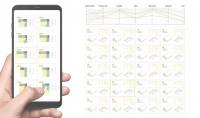New method of designing energy-efficient houses
WiseBuild – a digital conceptual solutions assistant – allows clients to actively participate in designing their own energy-efficient house. It is an alternative to catalogue designs, invented as part of a Master’s thesis at the PW Faculty of Architecture. The author is Damian Granosik.
– Data has become an interactive design parameter which we can process, analyse and evaluate at the conceptual stage – emphasizes the WiseBuild creator. – A simulation and optimisation allow to analyse a greater number of cases. This influences the design concept, which meets the requirements of energy-efficient and economic building. Sun exposure, shade, solar gains or visual comfort are factors that impact the quality of the designed space and their analysis may contribute to conscious design decisions.
Tailoring to the location and investor’s individual needs does not exist in catalogue designs but it is the basis of a successful design of a house.
– Problems generated by popular ready-made projects outweigh the benefits – stresses Damian Granosik. – When we use catalogue architectural solutions on a mass scale, we are confronting a landscape of mismatched houses.
That is why the young architect proposed a method which uses the advantages of a typical, individual and energy-efficient project.
– This approach allows to obtain a large number of personalised solutions, adapting the location of the building towards the cardinal directions and location, which will result in lower construction and maintenance costs – explains the WiseBuild creator. – This strategy may be an alternative to catalogue projects and allows an active participation of the investor in designing their own house, not giving up on the services of an architect.
The proposed solution may perform the role of an advisor – it proposes optimal solutions to the investor and designers, but also leaves space for creative work.
The diploma project of Damian Granosik was completed under the supervision of Ewelina Gawell, PhD, and it was distinguished in an international competition Design Educates Awards – aimed at designers and architects, who through their work want to make a change in the world. The idea from the Warsaw University of Technology got an honorary award in the Architectural Design category.
The concept is one thing but presenting it is something else. To present his approach, Damian Granosik chose a plot of land in Ezopa Street in Warsaw. From a generated catalogue of a dozen functional schemes, he selected a first floor layout that has a clear distribution of rooms. He left the western part of the plot intact, maintaining the natural landscape and tree stand.
In shaping the architectural form, Damian Granosik distinguished a few stages. The first decision, which is also the main principle of the proposed configurator for creating functional schemes, was to choose a simple, compact block on a rectangular plan with a gabled roof. The asymmetrical roof will allow to increase the solar gains from photovoltaic panels. The garage, located outside the building block, creates a buffer space between the blocks. This space is also the entrance zone of the house and to the garden.
Interestingly, Damian Granosik dispensed with window and door openings on the north side of the house. The window openings, partially defined using an optimisation process, open the building to the south and west of the world.
The author also cared for visual coherence. He used clinker brick (various bonding methods and formats) and wood (European larch matches both the trees on the plot of land and the bricks). Wooden elements (such as parts of the canopy or blinds) are in line with the energy-efficiency of the project.
– Popularisation of energy-efficient solutions in single-family houses seems indispensable and vital since we are facing the global energy crisis – sums up Damian Granosik.
Source: Architektura i Biznes








